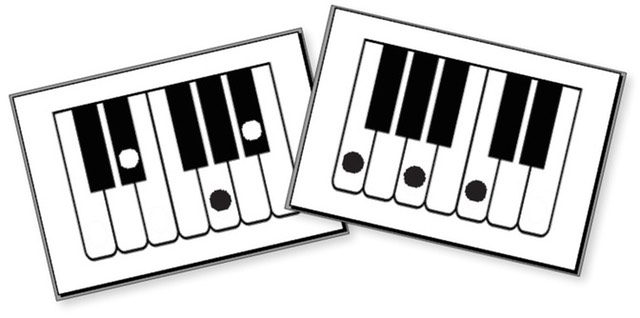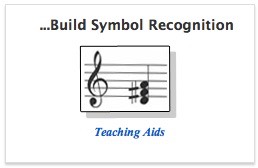
Click to See “Chords Go-Fish” Game
More Chords In A Flash! Activities:
1. Explore Chord Sounds: Let students experience a variety of chord sounds first and then attach a symbol or chord name: Have students randomly select several chord cards, then play and listen to each. (Student may play chords, one note at a time and/or three notes all together, using one or both hands to begin with). Ask them to notice the various “feelings” each different chord can express. Students in a class may take turns choosing and playing chord cards for each other. Listeners can describe or “guess” chord “feeling,” or draw their interpretation of a chord’s sound, for example with facial expressions. (There is no “right” or “wrong” answer here).
2. Name the Chords: (**See “Flashcard Go Fish” Game): Teacher (or student(s)) sorts the twelve major chords into their “color groups:” Set 1) all white keys—C, F, and G major chords; Set 2) black middle key—A, D, and E major; Set 3) black keys on outside—Ab, Db, and Eb; Set 4) “Odd” chords—Gb, Bb, and B major. Student looks at cards chosen from one chord-set at a time, and practices naming chords (answer on card’s reverse). Student chooses a card from a set and plays in different registers on the keyboard. Or, student plays chord with different dynamics, etc. Alternatively, student names the notes in the chord, and notates chords. (Related materials include: Music for Piano 1 and companion books: pgs 27-29 as well as earlier pages; Piano Plain and Simple for Adult Beginners Chapter 9 as well as earlier pages; Musical Games and Activities Chapter 6.)
3. Improvising With Chord Cards: Student picks several chords from entire deck. Or, student picks from a set that teacher pre-selects (for example: all C chords (augmented, major, minor, diminished), or any augmented chord, or only chords with a black key in the middle, or only C, F, and G minor), or a G, C, D [I-IV-V] chord progression, etc.). Student(s) improvises with chords, for example: Student plays each individual note of a chord in different orders and rhythms. Other times student plays all three notes together, divided between hands, in one hand, or as a chord in each hand. Later, student a) plays chords from several cards in succession, b) plays different chords together simultaneously (for bi-chordal sound). Students can tell a musical story, create movie scene, etc. by playing these various chords in different ways in various registers using different touches and dynamics, with or without pedal.
4. Ear Training: Teacher selects a set of cards that contain chords sharing the same keynote name (e.g. C major and C minor; or F# augmented, F# major, F# minor, and F# diminished, etc). Teacher or student chooses a card without showing it and plays the chord. Another student listens and tries to play back the same chord. If student “misses,” first student repeats chord until other student “finds” it. Or several students take turns trying to find the chord, or help one another find the chord. Alternately, after hearing chord, student tries to correctly name or notate the chord.
5. Notation: Teacher selects a set of cards, e.g. all chords on D, or all diminished chords, or, eventually, all chords in the deck. Teacher also selects matching notated chord flashcards. Student chooses a Chords-In-A-Flash flashcard and then finds the matching notated chord flashcard. Or, student or groups of students race to see how many matches can be made within a time limit.

